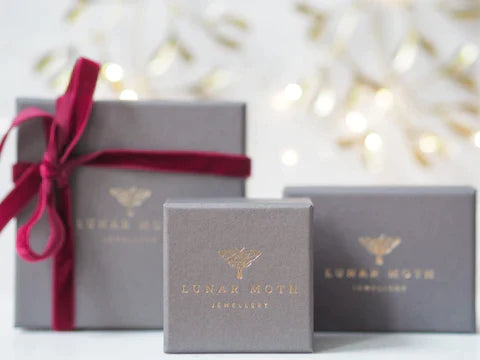How to Clean Sterling Silver That Has Turned Black
Sterling silver is a classic and timeless material that is often used to create high-end jewellery pieces. However, one issue that can occur with sterling silver is that it can turn black over time, which can be frustrating for those who want to maintain the beauty and shine of their silver jewellery. Luckily, there are ways to clean sterling silver that has turned black, and with a little bit of effort, you can restore your silver to its former glory.
What Does It Mean When Sterling Silver Turns Black?
When sterling silver turns black, it means that it has oxidized. Oxidation is a chemical reaction that occurs when the silver comes into contact with air or other substances such as sulphur or chlorine. This reaction causes a blackish-grey film to form on the surface of the silver, which can make it look dull and lifeless.
Why Does Sterling Silver Turn Black?
There are several reasons why sterling silver can turn black. One of the main reasons is exposure to air and moisture, which can cause the silver to oxidize. Other factors that can contribute to the oxidation of silver include exposure to chemicals such as chlorine and sulphur, as well as contact with certain materials such as rubber and wool.
Can You Fix Silver That Turned Black?
The good news is that it is possible to fix silver that has turned black. While it may require some effort and patience, there are several methods that you can use to clean and restore your silver to its former shine.
How to Clean Sterling Silver That Has Turned Black
There are several methods that you can use to clean sterling silver that has turned black. Some of the most effective methods include using aluminium foil, toothpaste, and home remedies. Here is a closer look at each of these methods:
How to Clean Sterling Silver with Aluminium Foil
One of the most popular methods for cleaning sterling silver that has turned black is using aluminium foil. This method is effective because it uses a chemical reaction to remove the oxidation from the silver.
To clean sterling silver with aluminium foil, you will need:
- Aluminium foil
- Baking soda
- Boiling water
- A bowl
- A soft cloth
Here are the steps to follow:
- Line a bowl with aluminium foil, shiny side up.
- Add 1 tablespoon of baking soda to the bowl.
- Place your tarnished silver jewellery in the bowl, making sure it is touching the aluminium foil.
- Pour enough boiling water into the bowl to cover the silver jewellery.
- Let the jewellery soak for 5-10 minutes, or until the tarnish is gone.
- Carefully remove the jewellery from the bowl using tongs or a spoon.
- Rinse the jewellery with cool water.
- Dry the jewellery with a soft cloth.
How to Clean Sterling Silver with Toothpaste
Another popular method for cleaning sterling silver that has turned black is using toothpaste. Toothpaste is effective because it contains mild abrasives that can help to remove the oxidation from the silver.
To clean sterling silver with toothpaste, you will need:
- Toothpaste (white, non-gel)
- A soft-bristled toothbrush
- Warm water
- A soft cloth
Here are the steps to follow:
- Apply a small amount of toothpaste to the soft-bristled toothbrush.
- Gently scrub the tarnished silver jewellery with the toothbrush, making sure to cover all areas.
- Rinse the jewellery with warm water.
- Dry the jewellery with a soft cloth.
What Is the Best Home Remedy to Clean Silver That Has Turned Black?
If you prefer to use a home remedy to clean your silver that has turned black, there are several options to choose from. One of the best home remedies for cleaning silver is using a mixture of baking soda and vinegar.
To clean sterling silver with a baking soda and vinegar mixture, you will need:
- 1 tablespoon of baking soda
- 1 tablespoon of white vinegar
- A bowl
- A soft cloth
Here are the steps to follow:
- Mix the baking soda and white vinegar together in a bowl to form a paste.
- Use a soft cloth to apply the paste to the tarnished silver jewellery.
- Let the paste sit on the jewellery for 10-15 minutes.
- Rinse the jewellery with warm water.
- Dry the jewellery with a soft cloth.
Another home remedy for cleaning silver is using lemon juice and salt. Lemon juice contains citric acid, which can help to remove oxidation from the silver, and salt is abrasive, which can help to scrub away the tarnish.
To clean sterling silver with lemon juice and salt, you will need:
- 1 lemon
- 1 tablespoon of salt
- A bowl
- A soft cloth
Here are the steps to follow:
- Cut the lemon in half and squeeze the juice into a bowl.
- Add 1 tablespoon of salt to the bowl and mix well.
- Use a soft cloth to apply the mixture to the tarnished silver jewellery.
- Let the mixture sit on the jewellery for 5-10 minutes.
- Rinse the jewellery with warm water.
- Dry the jewellery with a soft cloth.
Which Cleaning Methods are Suitable for Cleaning Silver Inset with Precious Stones?
If your silver jewellery is inset with precious stones, you will need to take extra care when cleaning it. Precious stones such as diamonds, emeralds and rubies are generally hard and durable, but they can still be damaged if not cleaned properly. Some cleaning methods, such as the use of harsh chemicals or abrasive materials, can scratch or damage the surface of the stones, leaving them looking dull and less vibrant.
To clean silver jewellery that is inset with precious stones, you should avoid using harsh chemicals and abrasive materials. Instead, use a soft cloth and a gentle cleaning solution to clean the silver without damaging the stones. A good option for cleaning such jewellery is to mix a few drops of mild dish soap with warm water. Use a soft-bristled brush to gently scrub the silver and the stones, being careful not to scratch the stones or damage any delicate settings.
Another option is to use a specially formulated silver jewellery cleaning solution that is safe for use with precious stones. These solutions are designed to clean silver without harming the stones and can be found at most jewellery stores.
What is the Best Type of Cleaning Cloth to Use for Cleaning Silver that has Turned Black?
The type of cleaning cloth you use to clean your silver jewellery can make a big difference in the effectiveness of the cleaning process. Ideally, you should use a soft, lint-free cloth that is specifically designed for cleaning silver. A microfiber cloth is an excellent option for cleaning silver jewellery as it is gentle and non-abrasive, making it ideal for removing dirt and tarnish without scratching the surface of the silver.
When choosing a cleaning cloth, it is important to avoid using anything that is rough or abrasive as this can damage the silver and leave scratches. You should also avoid using paper towels or tissues as these can leave behind fibres that can get caught in the small crevices and settings of your jewellery.
What Will Happen to My Silver Jewellery That Has Turned Black if I Do Not Clean It?
If you don't clean your silver jewellery that has turned black, it will continue to tarnish over time. Tarnishing can cause the silver to become discoloured and lose its shine, which can detract from its beauty and value. Tarnish can also cause silver to become brittle and more prone to damage.
Furthermore, the longer you leave your silver jewellery untreated, the more difficult it will be to clean later on. Heavy tarnish can be difficult to remove, and may require professional cleaning or restoration services.
If My Silver Jewellery Turns Black, Will Its Value Be Affected?
The value of your silver jewellery may be affected if it turns black due to tarnishing. While tarnish does not necessarily mean that the silver is damaged or compromised, it can detract from the appearance and value of the piece. Some collectors and buyers may view tarnish as a negative characteristic, and may be less willing to pay a premium price for a piece that has not been well-maintained.
However, it's important to note that the value of your silver jewellery will depend on a variety of factors, including the quality of the metal, the rarity of the design, and the condition of the piece overall. If you have a highly sought-after piece of silver jewellery that has turned black, its value may not be affected as much as a more common piece.
Conclusion
Sterling silver is a beautiful and valuable metal that can last a lifetime with proper care and maintenance. When silver jewellery turns black, it can be frustrating and disheartening, but it is important to remember that this is a natural process that can be easily remedied with a few simple cleaning methods.
By understanding the causes of tarnish and the best ways to clean silver, you can keep your jewellery looking its best for years to come. Remember to always store your silver in a dry, cool place, avoid exposing it to harsh chemicals and abrasive materials, and clean it regularly using gentle, non-abrasive methods.
With a little care and attention, your sterling silver jewellery can continue to shine and sparkle, making you feel confident and glamorous every time you wear it.

